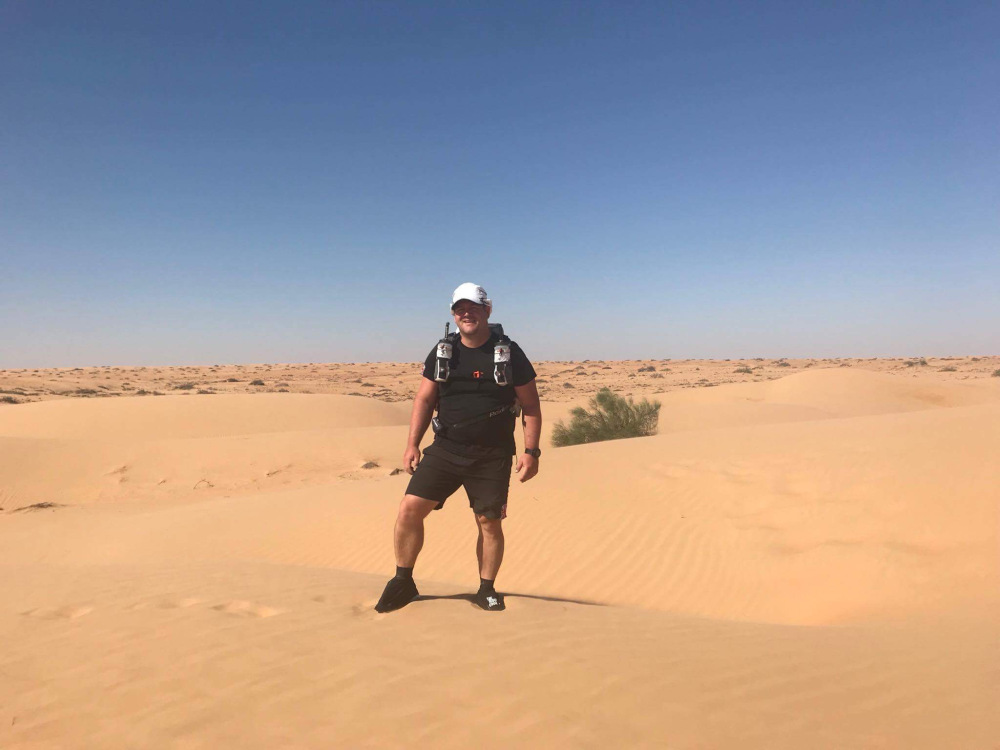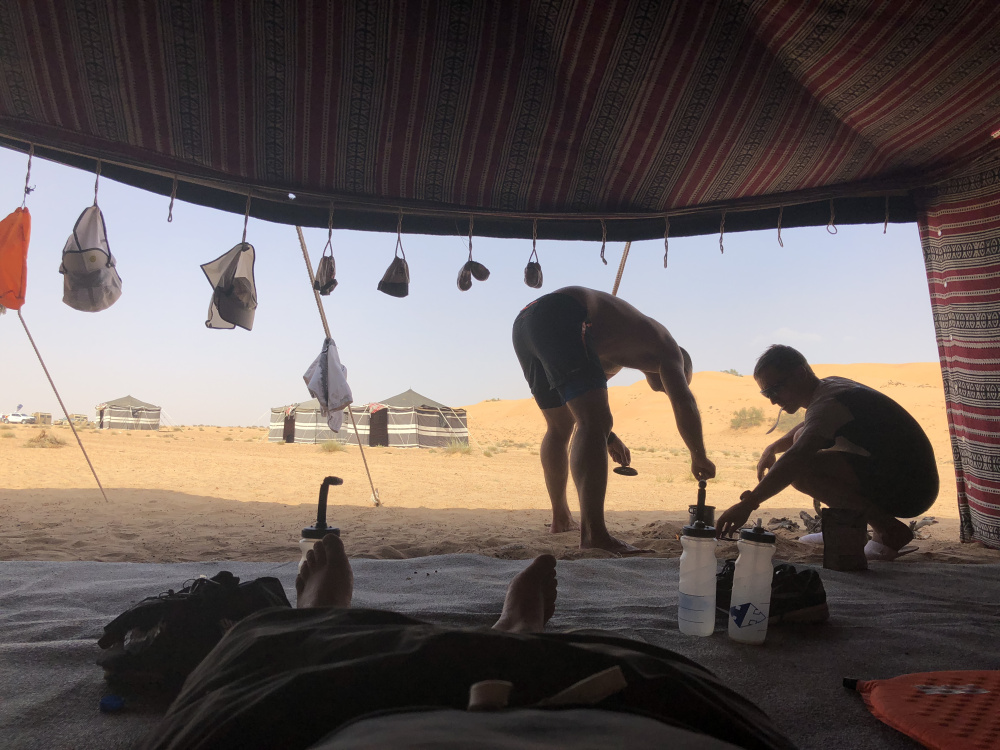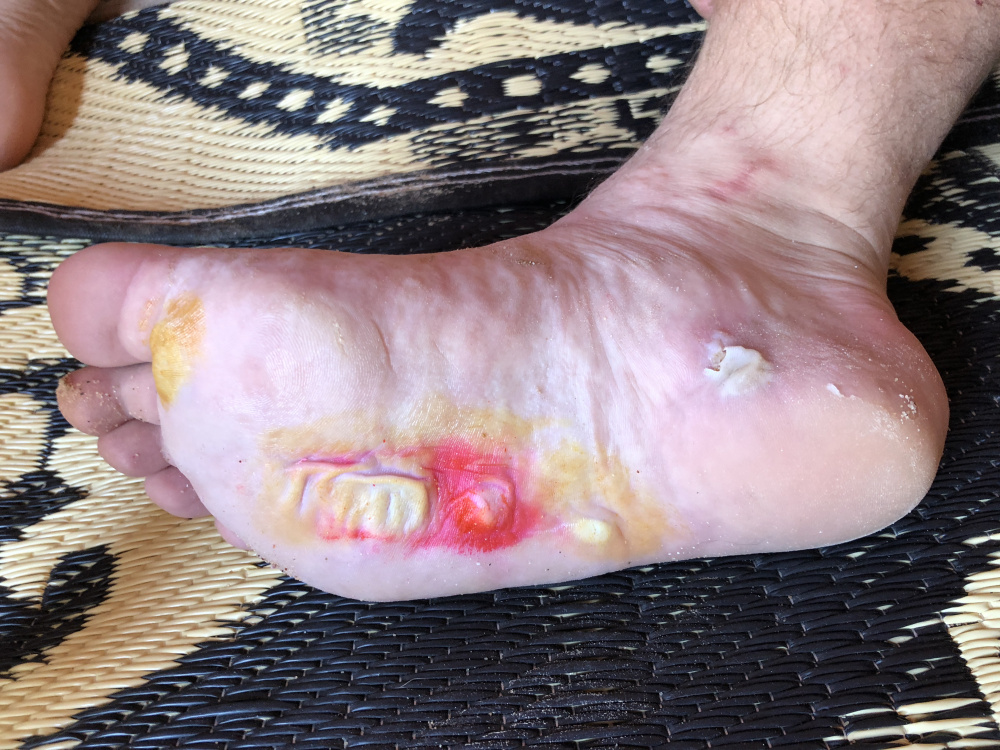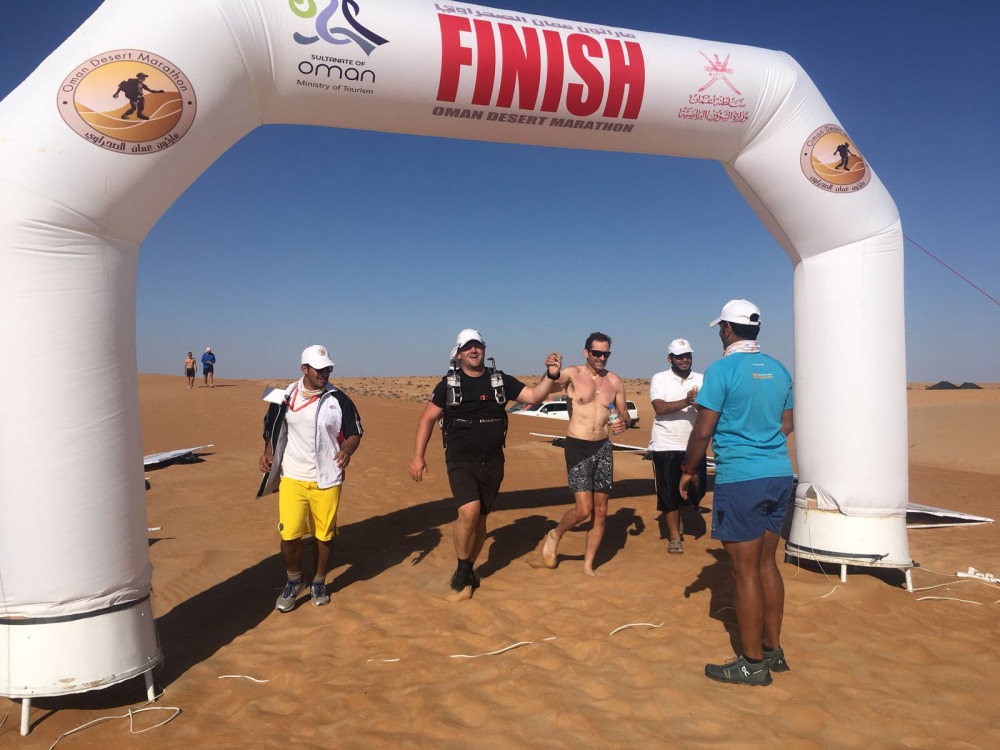
I’d started this stage of the race at 2pm and by 6 it was pitch black. My head torch was my only source of light guiding me across the dunes. Day five of the 165km self-sustained Oman Desert Marathon, 26km into the 42km night stage. I’d been passed by every other runner and my feet were in excruciating pain. I stopped, slumped down on a small sand dune and started thinking of excuses. A way of telling my friends and wife and children that I’d done my best but come up short.
Six days earlier I had left Hong Kong with my running partner Steve and flown to Bangkok, then switched planes to Muscat. The trip was uneventful except for an annoyingly constant knot in my stomach. Apprehension. On paper I knew what lay ahead, however I also knew the reality is always a little different. I’d packed and repacked my RaidLight 20L backpack ten times the night before, it was bursting at the seams. This was my first multi stage endurance race and I knew none of the tricks of the trade when it comes to packing.
The doctor advised that if I ever felt that way again I would need intravenous fluids.
The race started 45 minutes south of Nizwa with rather a lot of pomp and ceremony, since stage one coincided with Oman National Day which recognized Oman independence from Portugal in 1650. After this relatively easy stage we were transferred by coach and then 4-wheel drive into the desert, a drive of 200km, for our first camp. From this day forward we camped where we finished the day’s run as we made a beeline to the coast and the Arabian sea.
We quickly settled into the life of a multistage race. Eat, sleep, run with the occasional wash where we could. Talk became very much about caloric intake, how horrible the food was, blisters, and the varying consistencies of sand.

Six days food, sleeping bag, mat, salt, energy bars, cooker, survival kit and 3 packs Marlboro Lights.
One thing that became immediately obvious was that there were some very good runners in this race: in total, 101 total participants, including Mohammed Almorabity from Morocco, and Natalia Sedykh running out of Dubai for Adidas Running Moscow, and female winner of the 2016 Marathon Des Sables in the Morrocan Sahara. It took me very little time to work out that the race I was running would be against myself. The leaderboard didn’t matter and finishing the challenge was going to be my own personal battle.
Things started to hot up on day four. The stage was entitled “The Virgin Dunes” and it certainly delivered: 28km of beautiful dunes that punished my legs beyond belief on an extremely hot day.
Experiencing a feeling for the first time where I felt incredibly nauseous, to the extent I couldn’t drink water, I was also acutely aware I was dehydrated and needed to take on water. This feeling accompanied me for the last 5km of the stage and made crossing the finish line of the stage — and dousing myself in water in the shade of a truck — a very welcome relief.

Mr. Wright standing on his chosen medium. "Wouldn't firm turf be nice about now . . ."
On the positive side, stage five didn’t start until 2pm the next day, giving me 24 hours to rest and recover as best I could. Speaking to the doctor during some down time that evening she advised that if I ever felt that way again I would need intravenous fluids, and, potentially need to withdraw from the race.
Whilst sleep was always a little disturbed — to be expected when you’re sharing an open fronted tent in the middle of the desert with 9 other people – the next morning was relatively relaxing. The slowest runners were to start at 2pm, the next group at 3pm and the elite runners at 4pm. I’d never covered the distance of a marathon before, so I was apprehensive; other mitigating factors included that the desert went pitch black at 6pm and the race was starting to take its toll on my body, which meant I knew I was in for a tough day/night.

Stop, get water, get food, get sleep, get up, go!
On the other stages everyone had started together. I saw the runners ahead of me and then they disappeared into the distance. With these staggered start times the faster runners caught up and overtook me. For a brief moment when I was along side them I saw and felt their speed and power intimately.
As darkness fell I enjoyed a moment of the novelty of running along with my head torch on, yet soon a combination of factors caused me to stop, sit down and work out how to exit the race in the most graceful way possible. Whilst the leaderboard shouldn’t matter, the two runners I was ahead of on the leaderboard were now ahead of me. The pain on the sole of my right foot was like driving a rusty nail in with every step. I was hungry and tired. I was really suffering.

The least of it . . .
It was at that moment, sitting on my own in the the darkness of the Oman desert that I had an epiphany of sorts. Not a grand one to do with my place in the universe — what it takes to overcome adversity or anything like it. What I realised was that sitting there feeling sorry for myself was getting me nowhere, literally. If I stood up and started moving, every painful step would move me closer to my destination. While it seemed pretty obvious I was in a bit of a state, I thought, “Okay, cut yourself a little slack.”
I pulled myself together, stood up and started moving. I made it to the finish line of this stage, the second last, at 1:45am, actually overtaking a few runners getting there. I was too tired to find my tent. I slept on the floor of the blister treatment tent in the middle of the camp. I made a cold “hot” chocolate to try and get some calories into my body. I fell asleep around 2:30am after having two sips of the ghastly drink. With the final stage starting at 7am the next morning I got up 3 1/2 hours later and went again.
I kept on going and did not stop, crossing the finish line 95th out of the 101 starters (5 did not finish). Even as I write this a week after I finished I’m not totally sure how I got through the last stage, #6: 23km of high, soft sand dunes. One active runner finished behind me. My time was 45 hours and 27 mins during the 6 stages. Putting that in context, the winner clocked 13 hours, 56 mins. Steve finished 52nd with an amazing time of 26 hours, 54 mins.

I will forever be grateful to my partner in crime, Steve Williamson, who went above and beyond helping me through this experience. At the end of our week in the desert we enjoyed one of the greatest beers in history.
If I learned anything it was the simple affirmation that you can overcome adversity and achieve things that you and others might not have thought possible. Believe in yourself and surround yourself with positive people. As the author John Bingham said, “The miracle isn’t that I finished. The miracle is that I had the courage to start.”
Whether in your professional or personal life, the important thing is to start. See you on the next one.
Read Part 1 of this series: 'Three reasons why I’m running across a desert'

JONNY WRIGHT is the Global Managing Director of Dow Jones, Director of News. Previously he was Circulation Director in Europe for The Wall Street Journal. He lives in Hong Kong and looks for whatever cycle challenge is on offer.

Why not give it a try?

Comments
Bravo. At times I weary from
Bravo. At times I weary of the media parade of natural talent being 'all it can be'. Sure, it's stunning to see what the perfectly formed human can accomplish with dedicated training. But it is ennobling to see what pure, bloody-minded grit can accomplish when it gives the finger to nature's unforgivable failure to give you the body or talent to run sand dunes or sing Donizetti arias: There needs to be a word for such endeavours . . . maybe call it 'gritting'.
Add new comment